Piestany in restaurants: edible and beautiful
 Bashny.Net
Bashny.Net
Piestany in restaurants are not just a design trend, but also performs an additional useful function — put on the tables customers fresh herbs. Until recently, living walls actively used in restaurants as a beautiful decorative element, but today's landscape designers went further and began to grow on them quite edible plants. Taking this concept into service, many restaurants in the world has acquired beneficial walls, which offer visitors a unique experience — to see where the ingredients for the restaurant meals.

Fitesten in the restaurant "Neskuchny sad" (Rostov-on-don)
Space saving
Colin Macrath, owner of Seattle Urban Farm Co, his entire life was devoted to vertical farms and phytosteam. His hands planted dozens of orchards and vegetable gardens in particular, and in public eating places (for example, in the famous Вastille Cafe & Bar in Seattle).
"I think soon the restaurants will increasingly interested in gardens and other green spaces in their territories, says Magrat.

Colin Macrath, owner of Seattle Urban Farn Co.
The only limiting factor for "green" development of the restaurant, in his opinion, is the lack of budget and space.
"For a restaurant all starts with finding space for a vegetable garden or green walls, explains Macrat. — Very often the owners of land on which there are restaurants, do not allow them to establish kitchen gardens on the roofs or to use the adjacent territory".

The Restaurant "Bastille" (Seattle)
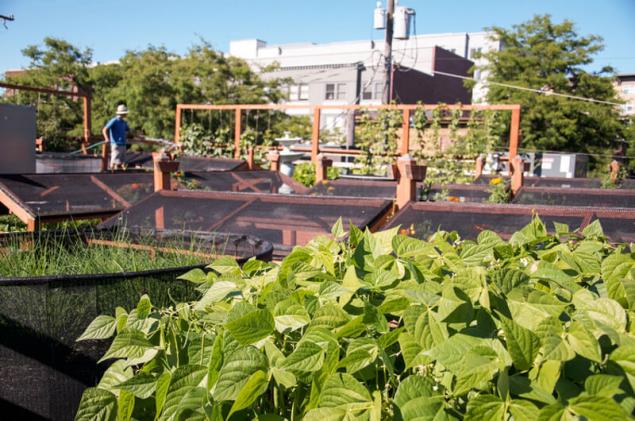
The garden on the roof of the restaurant "Bastille" (Seattle)
Therefore, to establish the restaurant's green wall is much easier than creating the whole farm. According to Macerata, Piestany helping to create a positive restaurant image. "People associate the restaurant with a garden that clearly demonstrates that there care about nature and think about the freshness of their products."
To be "green" in the eyes of their customers is far from all the restaurants. Vertical farms and Piestany can cost thousands of dollars and require constant maintenance and care. But the benefits of vertical gardening, are such costs.
A living object of art
One of the most famous and largest living walls is the restaurant "Padrinos" in Mexico city. More than 50 thousand plants planted on the wall, are designed to deal with environmental pollution. Lush ecosystem Piestany is both art object and an oxygen generator.
It's not just a wall, but at the same time — life picture, which gives visitors a strong impression.
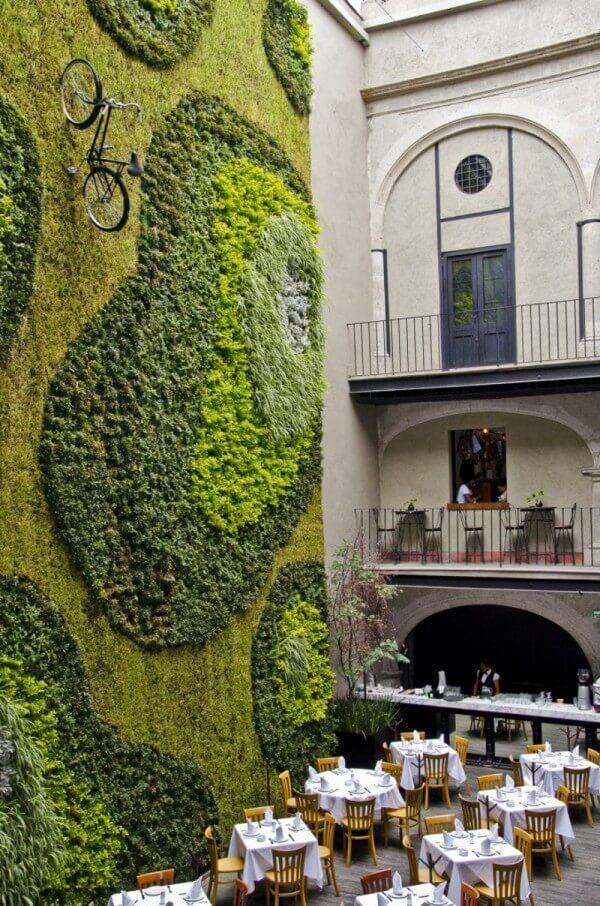
Giant fitesten in the restaurant "Padrino's" (Mexico)
"The people in the cafe I love to sit by the window and watch the wildlife. Therefore, the abundance of greenery in the premises attracts customers, says Leslie Ott, an interior designer Aria Architects (Chicago).
Leslie designed the living wall in the restaurant chain California Pizza Citchen (more than 120 restaurants in the United States and Mexico). Plants are placed in wooden displays and are mounted in the center of the bar.
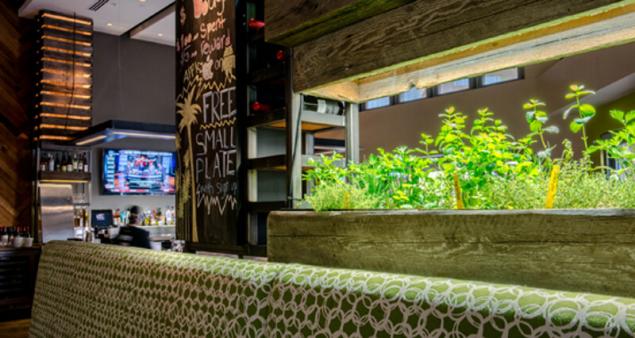
Restaurant "California Pizza Kitchen"
Another popular restaurant chain LYFE Kitchen specializing in organic cuisine, living walls fill the room with pleasant aromas. The restaurant LYFE Kitchen in Nevada VitaScene occupies the middle of the dining room and extends to 8 feet tall and 4 feet in length.
On the wall of aromatic herbs: lavender, rosemary, verbena, lemongrass, oregano. Piestany similar (though smaller) available in all 11 branches of this restaurant.
"Fitesten really touches our visitors. It becomes the visible place of the restaurant attracts the attention of visitors. Our visitors love to take pictures and then post these pictures on social networks, says NAT Cooper, co-founder and Manager at L3 Hospitality Group (restaurant chain LYFE Kitchen). — Wall, of course, not cheap, but they are worth it because the space bring a lot of personality. And they cost about the same how much it would cost us any architectural design or a piece of art".
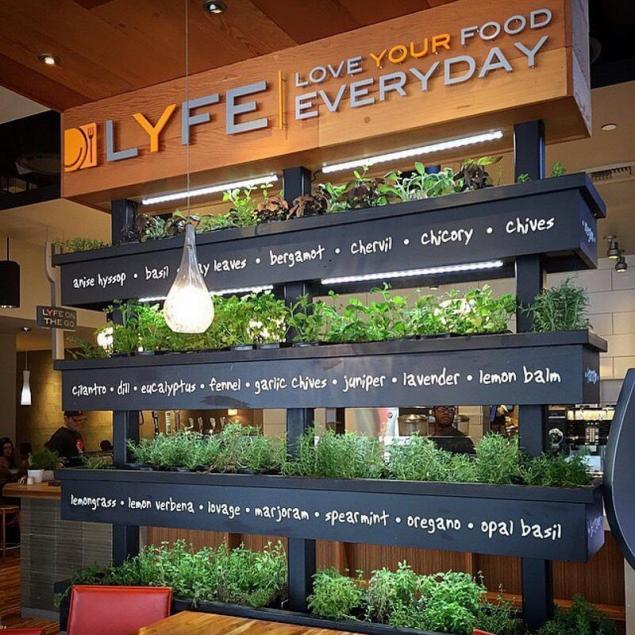
Herbs on the green wall of the restaurant "Kitchen Life"
"Russia has certainly followed the global trends, and our restaurants also began to appear Piestany. Even though they are still little, can be counted on the fingers, but they have said Asya Anistratenko, Director of the company RaStenia. — I met the living wall, made by very different techniques — cloth, peat, soil. Filistini like restaurateurs GINZA project. Has become widely popular giant VitaScene in a Moscow cafe Zodiac. In St. Petersburg is extensive and interesting green "chaihona №1" in the shopping complex "Gallery".

Trading center "Europe" (Ufa)
Among our customers the first experiment went Banquet hall "Mirror" in St. Petersburg — back in 2010 we set up a small composition of vertical gardening with a built-in waterfall. Fotomodel created a furor among the public Banquet hall. Later, we collaborated with the network of "teaspoon" in 2011 and 2012 in many teahouses in St. Petersburg appeared live photomodule.

Bicomodule in the cafe "teaspoon" (Saint Petersburg)
But the most interesting our restaurant the property is situated in Rostov-na-Donu, lush, and bright VitaScene size of about 24 sqm and Since 2011 she decorates the restaurant "Neskuchny garden" in the centre of Rostov".

The restaurant "Neskuchny sad" (Rostov-on-don)
Edible — not edible
Unfortunately, not all States in the US and Europe Piestany can be used for growing edible crops. In some cities, the law prohibits the use of plants inside the premises for commercial consumption. In such cases grass on faostino simply give the dining area a pleasant aroma.
But the owners of El Piano restaurant in the English city of York, have more ambitious plans — they are going to turn into "edible" fitesten part of its facade.
Liz Chadwick, a spokesman for El Piano, said the restaurant plans to cook a lot of dishes, which will be used all sorts of herbs and vegetables grown on the green facade.
When the owners of the restaurant El Piano decided to start implementing this idea, they are faced with many problems — was that due to the insufficient consideration of the legislative framework and due to the fact that the restaurant is located in the historical part of the city, to put him facade with plants is not so easy.
"We came to this idea two years ago and thought that after 6 months we will have a vertical farm. But it was more difficult, says Liz Chadwick. — The audience on this idea reacted very well. We even noticed that the occupancy of the restaurant has improved significantly since we announced our plans".
To obtain permission, the restaurant had to hold public hearings, and it is hoped that in a short time, El Piano will be able to implement this project. "We believe that it will be a great progress for the city and for a restaurant, and a major step toward the development of sustainable thinking, says the owner of the restaurant Magdalene Chavez.
In Russia the main obstacle to the implementation of such projects is the climate.
"Fotofacade possible in Russia, mainly in the southern oblasts, and Krasnodar Krai is the first candidate for the development of facade greening. We are always looking for partners and actively teach regional companies work on our technique. Perhaps in the near future the walls of houses in the South of Russia will not yield in beauty to the famous green facades, — said Asya Anistratenko. — However, while it is necessary to consider that the practice of such landscaping in Russia, and highlight the vertical plane under these experiments the city is not easy. There is still a lot of work on formation of ecological thinking in servants in the field of urban planning and protection of buildings. The idea of the ecological importance of extensive landscaping in the cities formed in Russia only partly".

Cell wall-the garden of the restaurant Mise en Place (Tampa, USA)
The restaurant Mise en Place (Tampa, Florida, USA) cell wall-the garden appears a couple of times a week. It brings here David Smaylz of the company Uriah''s Urban Farms. Customers often orders a salad "farmer Dave". The waiter goes to the wall and pinch off the leaves with lime, lettuce, arugula, Basil. Directly in front of the visitors he washes the herbs with ice water, dried with a soft white towel and mix with olive vinaigrette, almonds and croutons. What could be better!

Delicious greens at the restaurant Mise en Place
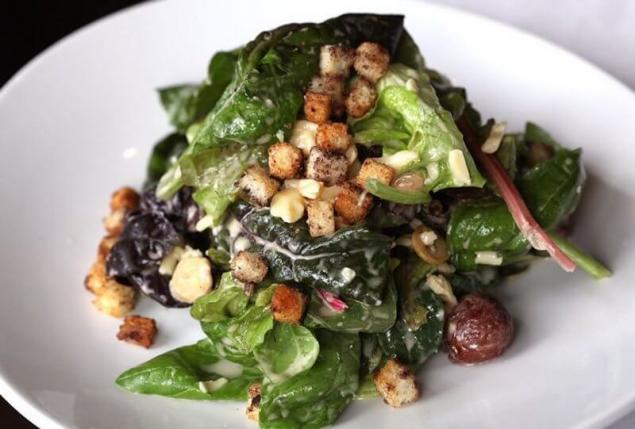
Salad "farmer Dave"
In Russia, this practice is not yet found.
"With edible plants in faostino practice we have no such projects were considered, but the embodiment is not reached — explains Asya Anistratenko. I think the specifics of this solution is that salad greens have become a renewable resource — the place used in the food bundle necessary to plant a new plant. Our technology is more designed for many years of cultivation of plants, than their temporary maintenance — this is because the plants in our faostino take root, grow and become part of the ecosystem. However, special obstacles to the creation of a "salad" or "spiced" Piestany our part no. And the load will increase, rather, not very much, and organizational purchasing.
Overall, our Piestany based on the principle of hydroponics, and on this basis we have historically grown many edible crops. But the vertical arrangement of plants imposes certain restrictions on the form used by the seedling — heavy fruit and long lashes will require additional support, which is on a vertical plane there is nowhere to take. Perhaps for the cultivation of edible fitosan with a wide range, we will need to significantly change the design. In the current faostino we can easily imagine the growing of salads, herbs, herbs. And, of course, it will be necessary to understand this decision from the point of view of sanitary inspection."
An investment in the future
Professionals of vertical gardening with the installation of living walls in restaurants have to deal with different difficulties associated with creating normal conditions for life of plants.
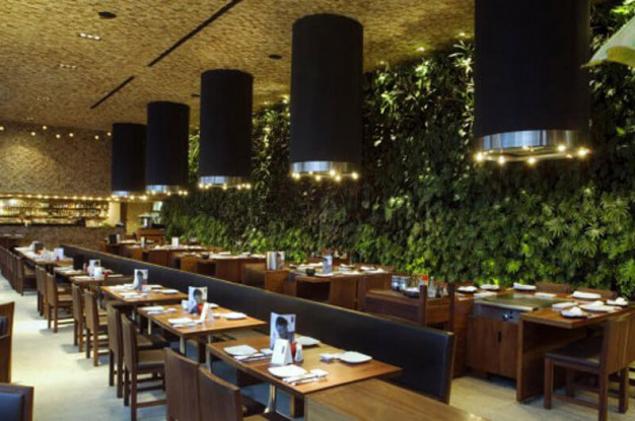
The Restaurant "Japonez"
"In each case, producers have to solve non-standard problems. Somewhere there is temperature changes. Somewhere — the need to create an intimate setting in the restaurant is contrary to the needs of plants, — says Asya Anistratenko. For example, in "Chaikhona №1" fitolampy for plants are included only in the night, in the daytime in the hall the light is soft, dim.
There are other harmful for plant factors — tobacco smoke (though since the ban on Smoking in public places the importance of this factor decreased), small acts of vandalism from visitors. All this leads to the fact that land is often a viable, low-maintenance plants. Either the owner consciously to the fact that periodically the vertical garden will be replenished with new copies instead of the victims. We prefer to plant in public supply plants, cleaning the air and easily tolerate the lack of lighting".
Like any other modern innovation, the installation of a living wall in the restaurant can greatly improve the status of the institution and at the same time require significant costs. In a sense, vertical gardening reminiscent of installing energy efficient equipment, it usually costs more traditional, but pays off in the future.
The same thing happens with the living walls in restaurants — in the long term they can give great returns. published
P. S. And remember, only by changing their consumption — together we change the world! © Join us at Facebook , Vkontakte, Odnoklassniki
Source: green-city.su/%EF%BB%BFfitosteny-v-restoranax-sedobnye-i-krasivye/
Tags
See also
A new method of storing herbs
Garden on the windowsill—herbs
Herbs in your garden: stocks for the winter, planting and care
Herbs in Your garden: the Union of use and beauty
How and what plants to create a spicy garden
6 herbs from seeds
On the run recipe: pickled cucumbers with red currant
Vertical mini-garden for the kitchen
7 Wonders of the Ancient World. It's amazing how this could build before our era!
7 Wonders of the Ancient World. It's amazing how this could build before our era!

















